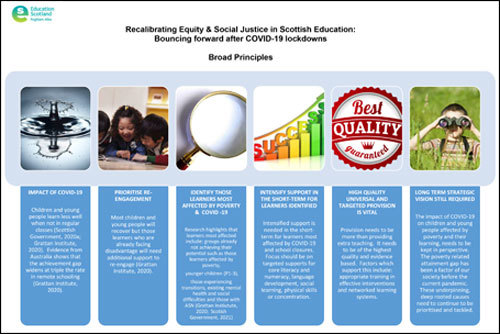Recalibrating Equity and Social Justice in Scottish Education: Bouncing forward after COVID-19 lockdowns
For many children and young people, socioeconomic inequity and its impact on remote learning during school closures will have exacerbated the poverty related attainment gap (Audit, Scotland, 2020; Engzell, Frey & Verhagen, 2020; Scottish Government, 2021; EEF, 2020a).
Indeed the pandemic itself has pushed more children into poverty and food insecurity has risen (Children and Young People’s Commission, 2020).
To effectively target support for children and young people most affected by poverty, COVID-19 and remote learning, educational establishments, local authorities and national agencies need to use data and research as part of an evidence base. Addressing the impact of this interrupted learning now will minimise further disruption (OECD, 2020).
 Research identifies 6 broad principles which can be used to help schools and local authorities consider their use of Scottish Attainment Challenge funding and supports to recalibrate equity and help learners to bounce forward after COVID-19 lockdowns and school closures:
Research identifies 6 broad principles which can be used to help schools and local authorities consider their use of Scottish Attainment Challenge funding and supports to recalibrate equity and help learners to bounce forward after COVID-19 lockdowns and school closures:
Research suggests that children and young people learn less well when not in regular classes (Fitzpatrick et al, 2020; Heppen et al, 2017). According to the Grattan Institute (2020), the achievement gap widens at triple the rate in remote schooling.
Most learners will recover but children and young people who are already facing disadvantage will need additional support to re-engage (Grattan Institute, 2020).
3. Identify those learners most impacted by poverty and COVID-19
To effectively target support and impact upon children and young people most affected by poverty and COVID-19, all educational establishments, local authorities and national agencies need to use data and research as an evidence base. Research highlights that learners most affected include: groups already finding it difficult to achieve their educational potential such as those affected by poverty, younger children (P1-3), those experiencing transitions, children and young people with existing mental health and social difficulties and those with ASN.
4. Intensify support in the short-term for learners identified
Intensified support is needed in the short-term for learners most affected by COVID-19 and school closures. Focus should be on targeted supports for core literacy and numeracy, language development, social learning, physical skills and/ or concentration.
5. High quality universal and targeted provision is vital
Provision needs to be more than just additional time and teaching. It needs to be of the highest quality and evidence based. Factors which support this include: appropriate training in interventions being delivered and networked learning systems.
6. Long-term strategic vision to close the poverty related attainment gap still required
The impact of COVID-19 on children and young people affected by poverty and their learning needs to be kept in perspective. The poverty related attainment has been a factor of our society before the current pandemic. These underpinning, deep rooted causes need to continue to be prioritised and tackled (Grattan Institute, 2020).
Download
PDF file: Recalibrating Equity and Social Justice in Scottish Education - Broad principles (313 KB)
PDF file: Recalibrating Equity and Social Justice in Scottish Education - visual (480 KB)
Improvement questions
- How are we ensuring we are hearing the voices of children and young people most affected by poverty and COVID-19 about their experiences of lockdown and re-engaging in education? How are we using this information to inform decisions going forward?
- What data does your establishment or class already have which identifies children and young people most affected by poverty, COVID-19 and school closures?
- Does this follow similar or different patterns to the research detailed in the 6 broad principles?
- Have you considered the groups of children and young people identified through the research?
- Have you considered which aspects of learning has been most impacted upon?
- And which skills, learning and understanding are most important for the foundations of their learning to build upon?
- How well are the children and young people most affected by the pandemic and its restrictions returning to education – physically, emotionally and socially?
- Are the assessments being used to measure progress equitable?
- How effective is your establishment’s or class implementation of small group interventions to intensify support for those children and young people who need it most? How do you know? Is the intervention being delivered of high quality with clear outcomes and measures which everyone is aware of?
- How do these plans for short-term intensified support fit with your longer term vision and plans for closing the poverty related attainment gap?
